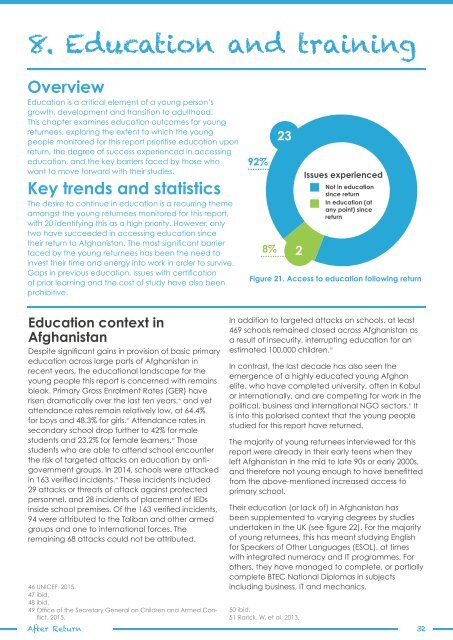After Return
After%20Return_RSN_April%202016
After%20Return_RSN_April%202016
You also want an ePaper? Increase the reach of your titles
YUMPU automatically turns print PDFs into web optimized ePapers that Google loves.
8. Education and training<br />
Overview<br />
Education is a critical element of a young person’s<br />
growth, development and transition to adulthood.<br />
This chapter examines education outcomes for young<br />
returnees, exploring the extent to which the young<br />
people monitored for this report prioritise education upon<br />
return, the degree of success experienced in accessing<br />
education, and the key barriers faced by those who<br />
want to move forward with their studies.<br />
Key trends and statistics<br />
The desire to continue in education is a recurring theme<br />
amongst the young returnees monitored for this report,<br />
with 20 identifying this as a high priority. However, only<br />
two have succeeded in accessing education since<br />
their return to Afghanistan. The most significant barrier<br />
faced by the young returnees has been the need to<br />
invest their time and energy into work in order to survive.<br />
Gaps in previous education, issues with certification<br />
of prior learning and the cost of study have also been<br />
prohibitive.<br />
92%<br />
8%<br />
23<br />
2<br />
Issues experienced<br />
Not in education<br />
since return<br />
In education (at<br />
any point) since<br />
return<br />
Figure 21. Access to education following return<br />
Education context in<br />
Afghanistan<br />
Despite significant gains in provision of basic primary<br />
education across large parts of Afghanistan in<br />
recent years, the educational landscape for the<br />
young people this report is concerned with remains<br />
bleak. Primary Gross Enrolment Rates (GER) have<br />
risen dramatically over the last ten years, 46 and yet<br />
attendance rates remain relatively low, at 64.4%<br />
for boys and 48.3% for girls. 47 Attendance rates in<br />
secondary school drop further to 42% for male<br />
students and 23.2% for female learners. 48 Those<br />
students who are able to attend school encounter<br />
the risk of targeted attacks on education by antigovernment<br />
groups. In 2014, schools were attacked<br />
in 163 verified incidents. 49 These incidents included<br />
29 attacks or threats of attack against protected<br />
personnel, and 28 incidents of placement of IEDs<br />
inside school premises. Of the 163 verified incidents,<br />
94 were attributed to the Taliban and other armed<br />
groups and one to international forces. The<br />
remaining 68 attacks could not be attributed.<br />
46 UNICEF. 2015.<br />
47 ibid.<br />
48 ibid.<br />
49 Office of the Secretary General on Children and Armed Conflict.<br />
2015.<br />
In addition to targeted attacks on schools, at least<br />
469 schools remained closed across Afghanistan as<br />
a result of insecurity, interrupting education for an<br />
estimated 100,000 children. 50<br />
In contrast, the last decade has also seen the<br />
emergence of a highly educated young Afghan<br />
elite, who have completed university, often in Kabul<br />
or internationally, and are competing for work in the<br />
political, business and international NGO sectors. 51 It<br />
is into this polarised context that the young people<br />
studied for this report have returned.<br />
The majority of young returnees interviewed for this<br />
report were already in their early teens when they<br />
left Afghanistan in the mid to late 90s or early 2000s,<br />
and therefore not young enough to have benefitted<br />
from the above-mentioned increased access to<br />
primary school.<br />
Their education (or lack of) in Afghanistan has<br />
been supplemented to varying degrees by studies<br />
undertaken in the UK (see figure 22). For the majority<br />
of young returnees, this has meant studying English<br />
for Speakers of Other Languages (ESOL), at times<br />
with integrated numeracy and IT programmes. For<br />
others, they have managed to complete, or partially<br />
complete BTEC National Diplomas in subjects<br />
including business, IT and mechanics.<br />
50 ibid.<br />
51 Rarick, W. et al. 2013.<br />
<strong>After</strong> <strong>Return</strong> 32


